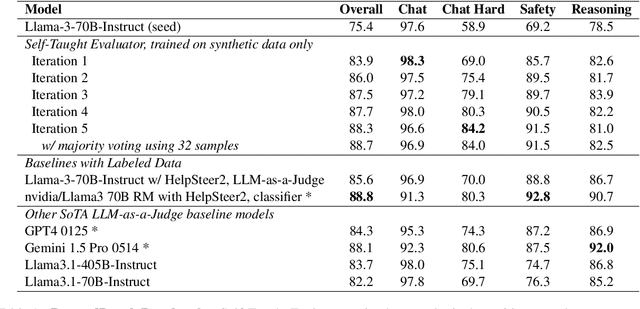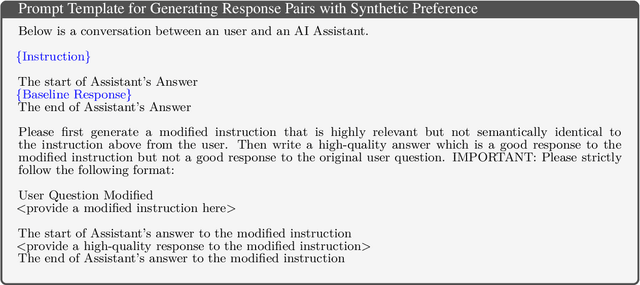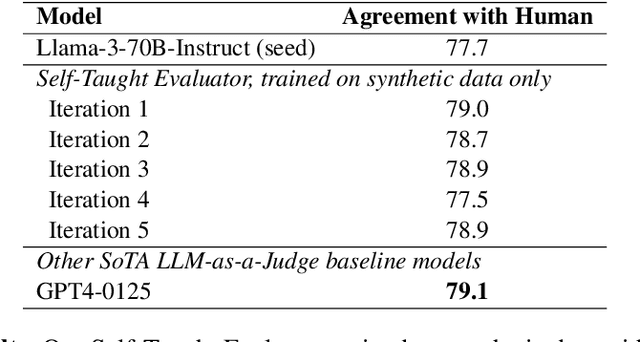Ping Yu
V-MAGE: A Game Evaluation Framework for Assessing Visual-Centric Capabilities in Multimodal Large Language Models
Apr 08, 2025Abstract:Recent advancements in Multimodal Large Language Models (MLLMs) have led to significant improvements across various multimodal benchmarks. However, as evaluations shift from static datasets to open-world, dynamic environments, current game-based benchmarks remain inadequate because they lack visual-centric tasks and fail to assess the diverse reasoning skills required for real-world decision-making. To address this, we introduce Visual-centric Multiple Abilities Game Evaluation (V-MAGE), a game-based evaluation framework designed to assess visual reasoning capabilities of MLLMs. V-MAGE features five diverse games with 30+ handcrafted levels, testing models on core visual skills such as positioning, trajectory tracking, timing, and visual memory, alongside higher-level reasoning like long-term planning and deliberation. We use V-MAGE to evaluate leading MLLMs, revealing significant challenges in their visual perception and reasoning. In all game environments, the top-performing MLLMs, as determined by Elo rating comparisons, exhibit a substantial performance gap compared to humans. Our findings highlight critical limitations, including various types of perceptual errors made by the models, and suggest potential avenues for improvement from an agent-centric perspective, such as refining agent strategies and addressing perceptual inaccuracies. Code is available at https://github.com/CSU-JPG/V-MAGE.
Diverse Preference Optimization
Jan 31, 2025



Abstract:Post-training of language models, either through reinforcement learning, preference optimization or supervised finetuning, tends to sharpen the output probability distribution and reduce the diversity of generated responses. This is particularly a problem for creative generative tasks where varied responses are desired. In this work we introduce Diverse Preference Optimization (DivPO), an optimization method which learns to generate much more diverse responses than standard pipelines, while maintaining the quality of the generations. In DivPO, preference pairs are selected by first considering a pool of responses, and a measure of diversity among them, and selecting chosen examples as being more rare but high quality, while rejected examples are more common, but low quality. DivPO results in generating 45.6% more diverse persona attributes, and an 74.6% increase in story diversity, while maintaining similar win rates as standard baselines.
R.I.P.: Better Models by Survival of the Fittest Prompts
Jan 30, 2025



Abstract:Training data quality is one of the most important drivers of final model quality. In this work, we introduce a method for evaluating data integrity based on the assumption that low-quality input prompts result in high variance and low quality responses. This is achieved by measuring the rejected response quality and the reward gap between the chosen and rejected preference pair. Our method, Rejecting Instruction Preferences (RIP) can be used to filter prompts from existing training sets, or to make high quality synthetic datasets, yielding large performance gains across various benchmarks compared to unfiltered data. Using Llama 3.1-8B-Instruct, RIP improves AlpacaEval2 LC Win Rate by 9.4%, Arena-Hard by 8.7%, and WildBench by 9.9%. Using Llama 3.3-70B-Instruct, RIP improves Arena-Hard from 67.5 to 82.9, which is from 18th place to 6th overall in the leaderboard.
Adaptive Decoding via Latent Preference Optimization
Nov 14, 2024



Abstract:During language model decoding, it is known that using higher temperature sampling gives more creative responses, while lower temperatures are more factually accurate. However, such models are commonly applied to general instruction following, which involves both creative and fact seeking tasks, using a single fixed temperature across all examples and tokens. In this work, we introduce Adaptive Decoding, a layer added to the model to select the sampling temperature dynamically at inference time, at either the token or example level, in order to optimize performance. To learn its parameters we introduce Latent Preference Optimization (LPO) a general approach to train discrete latent variables such as choices of temperature. Our method outperforms all fixed decoding temperatures across a range of tasks that require different temperatures, including UltraFeedback, Creative Story Writing, and GSM8K.
Self-Taught Evaluators
Aug 05, 2024



Abstract:Model-based evaluation is at the heart of successful model development -- as a reward model for training, and as a replacement for human evaluation. To train such evaluators, the standard approach is to collect a large amount of human preference judgments over model responses, which is costly and the data becomes stale as models improve. In this work, we present an approach that aims to im-prove evaluators without human annotations, using synthetic training data only. Starting from unlabeled instructions, our iterative self-improvement scheme generates contrasting model outputs and trains an LLM-as-a-Judge to produce reasoning traces and final judgments, repeating this training at each new iteration using the improved predictions. Without any labeled preference data, our Self-Taught Evaluator can improve a strong LLM (Llama3-70B-Instruct) from 75.4 to 88.3 (88.7 with majority vote) on RewardBench. This outperforms commonly used LLM judges such as GPT-4 and matches the performance of the top-performing reward models trained with labeled examples.
Distilling System 2 into System 1
Jul 09, 2024



Abstract:Large language models (LLMs) can spend extra compute during inference to generate intermediate thoughts, which helps to produce better final responses. Since Chain-of-Thought (Wei et al., 2022), many such System 2 techniques have been proposed such as Rephrase and Respond (Deng et al., 2023a), System 2 Attention (Weston and Sukhbaatar, 2023) and Branch-Solve-Merge (Saha et al., 2023). In this work we investigate self-supervised methods to ``compile'' (distill) higher quality outputs from System 2 techniques back into LLM generations without intermediate reasoning token sequences, as this reasoning has been distilled into System 1. We show that several such techniques can be successfully distilled, resulting in improved results compared to the original System 1 performance, and with less inference cost than System 2. We posit that such System 2 distillation will be an important feature of future continually learning AI systems, enabling them to focus System 2 capabilities on the reasoning tasks that they cannot yet do well.
Following Length Constraints in Instructions
Jun 25, 2024



Abstract:Aligned instruction following models can better fulfill user requests than their unaligned counterparts. However, it has been shown that there is a length bias in evaluation of such models, and that training algorithms tend to exploit this bias by learning longer responses. In this work we show how to train models that can be controlled at inference time with instructions containing desired length constraints. Such models are superior in length instructed evaluations, outperforming standard instruction following models such as GPT4, Llama 3 and Mixtral.
TCMD: A Traditional Chinese Medicine QA Dataset for Evaluating Large Language Models
Jun 07, 2024Abstract:The recently unprecedented advancements in Large Language Models (LLMs) have propelled the medical community by establishing advanced medical-domain models. However, due to the limited collection of medical datasets, there are only a few comprehensive benchmarks available to gauge progress in this area. In this paper, we introduce a new medical question-answering (QA) dataset that contains massive manual instruction for solving Traditional Chinese Medicine examination tasks, called TCMD. Specifically, our TCMD collects massive questions across diverse domains with their annotated medical subjects and thus supports us in comprehensively assessing the capability of LLMs in the TCM domain. Extensive evaluation of various general LLMs and medical-domain-specific LLMs is conducted. Moreover, we also analyze the robustness of current LLMs in solving TCM QA tasks by introducing randomness. The inconsistency of the experimental results also reveals the shortcomings of current LLMs in solving QA tasks. We also expect that our dataset can further facilitate the development of LLMs in the TCM area.
Efficient Tool Use with Chain-of-Abstraction Reasoning
Jan 30, 2024



Abstract:To achieve faithful reasoning that aligns with human expectations, large language models (LLMs) need to ground their reasoning to real-world knowledge (e.g., web facts, math and physical rules). Tools help LLMs access this external knowledge, but there remains challenges for fine-tuning LLM agents (e.g., Toolformer) to invoke tools in multi-step reasoning problems, where inter-connected tool calls require holistic and efficient tool usage planning. In this work, we propose a new method for LLMs to better leverage tools in multi-step reasoning. Our method, Chain-of-Abstraction (CoA), trains LLMs to first decode reasoning chains with abstract placeholders, and then call domain tools to reify each reasoning chain by filling in specific knowledge. This planning with abstract chains enables LLMs to learn more general reasoning strategies, which are robust to shifts of domain knowledge (e.g., math results) relevant to different reasoning questions. It also allows LLMs to perform decoding and calling of external tools in parallel, which avoids the inference delay caused by waiting for tool responses. In mathematical reasoning and Wiki QA domains, we show that our method consistently outperforms previous chain-of-thought and tool-augmented baselines on both in-distribution and out-of-distribution test sets, with an average ~6% absolute QA accuracy improvement. LLM agents trained with our method also show more efficient tool use, with inference speed being on average ~1.4x faster than baseline tool-augmented LLMs.
YAYI 2: Multilingual Open-Source Large Language Models
Dec 22, 2023Abstract:As the latest advancements in natural language processing, large language models (LLMs) have achieved human-level language understanding and generation abilities in many real-world tasks, and even have been regarded as a potential path to the artificial general intelligence. To better facilitate research on LLMs, many open-source LLMs, such as Llama 2 and Falcon, have recently been proposed and gained comparable performances to proprietary models. However, these models are primarily designed for English scenarios and exhibit poor performances in Chinese contexts. In this technical report, we propose YAYI 2, including both base and chat models, with 30 billion parameters. YAYI 2 is pre-trained from scratch on a multilingual corpus which contains 2.65 trillion tokens filtered by our pre-training data processing pipeline. The base model is aligned with human values through supervised fine-tuning with millions of instructions and reinforcement learning from human feedback. Extensive experiments on multiple benchmarks, such as MMLU and CMMLU, consistently demonstrate that the proposed YAYI 2 outperforms other similar sized open-source models.
 Add to Chrome
Add to Chrome Add to Firefox
Add to Firefox Add to Edge
Add to Edge